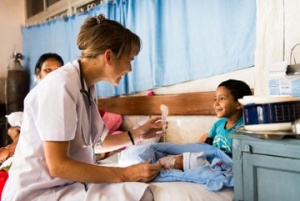Role of Physiotherapists in Global Health: Difference between revisions
No edit summary |
No edit summary |
||
| Line 16: | Line 16: | ||
{| width="100%" border="0" cellpadding="3" cellspacing="3" | {| width="100%" border="0" cellpadding="3" cellspacing="3" | ||
|- | |- | ||
| valign="top" | | valign="top" | <br> | ||
| valign="top" | | |||
'''Members of Inter-disciplinary Health Teams''' | |||
*For the provision of direct service <ref name="Summit" /> <ref name="Alappat">Alappat C, Siu G, Penfold A, McGovern B, McFarland J, Raman S, Landry MD. Role of Canadian Physical Therapists in Global Health Initiatives: SWOT Analysis. fckLRPhysiotherapy Canada. 2007; 59(4): 272-285.</ref> | *For the provision of direct service <ref name="Summit" /> <ref name="Alappat">Alappat C, Siu G, Penfold A, McGovern B, McFarland J, Raman S, Landry MD. Role of Canadian Physical Therapists in Global Health Initiatives: SWOT Analysis. fckLRPhysiotherapy Canada. 2007; 59(4): 272-285.</ref> | ||
|- | |- | ||
| | | <br> | ||
| valign="top" | '''Educators and Mentors related to''' <ref name="Summit" /> <ref name="Alappat" />: <br> | |||
*Prevention and management of non-communicable diseases and lifestyle-related conditions (e.g. obesity, diabetes, heart disease). This was a notable priority for all geographic regions represented at the 2007 Summit. <ref name="Summit" /> | *Prevention and management of non-communicable diseases and lifestyle-related conditions (e.g. obesity, diabetes, heart disease). This was a notable priority for all geographic regions represented at the 2007 Summit. <ref name="Summit" /> | ||
*Prevention of incidents such as workplace injuries | *Prevention of incidents such as workplace injuries | ||
| Line 40: | Line 32: | ||
|- | |- | ||
| | | <br> | ||
| | | | ||
'''Advocates''' | '''Advocates''' | ||
| Line 47: | Line 39: | ||
|- | |- | ||
| | | <br> | ||
| | | | ||
'''Screeners''' | '''Screeners''' | ||
| Line 57: | Line 49: | ||
|- | |- | ||
| | | <br> | ||
| | | | ||
'''Referees''' | '''Referees''' | ||
| Line 64: | Line 56: | ||
|- | |- | ||
| | | <br> | ||
| | | | ||
'''Consultants''' | '''Consultants''' | ||
| Line 72: | Line 64: | ||
|- | |- | ||
| | | <br> | ||
| | | | ||
Leaders and Active Participants | '''Leaders and Active Participants''' | ||
*In Health Policy Decision-Making <ref name="Summit" /> | |||
|} | |} | ||
Revision as of 23:00, 5 January 2017
Original Editor - Laura Ritchie with tremendous gratitude to members of the Global Health Division of the Canadian Physiotherapy Association for assistance with content for this article.
Top Contributors - Naomi O'Reilly, Gayatri Jadav Upadhyay, Kim Jackson, Robin Tacchetti, Tony Lowe, Jess Bell, Tarina van der Stockt, WikiSysop and Rucha Gadgil
Introduction[edit | edit source]
How Do Physiotherapists Fit Into Global Health Initiatives?[edit | edit source]
According to Mickan et al (2010), “there is a clear requirement for collaboration among health workers from different professional backgrounds as no one person is able to deliver care to meet the complete needs of the patient.” [1] Collaborative Practice is noted to “[occur] when multiple health workers provide comprehensive services by working together synergistically along with their patients, their families, carers and communities to deliver the highest quality of care across settings.” [1]
Physiotherapists are key members of collaborative inter-professional teams due to their broad scope of practice. As is typical with varying locales, the specific role of a physiotherapist varies according to the needs of the specific population in question. At the First Physical Therapy Summit on Global Health in 2007, the overarching roles of the physiotherapist as an “Agent of Change” and “Health Advocate” were discussed. [2] Some of these roles include:
|
Members of Inter-disciplinary Health Teams | |
Educators and Mentors related to [2] [3]:
| |
|
Advocates
| |
|
Screeners
| |
|
Referees
| |
|
Consultants
| |
|
Leaders and Active Participants
|
[4]
Sub Heading 2
[edit | edit source]
Recent Related Research (from Pubmed)[edit | edit source]
Extension:RSS -- Error: Not a valid URL: Feed goes here!!|charset=UTF-8|short|max=10
References[edit | edit source]
References will automatically be added here, see adding references tutorial.
- ↑ 1.0 1.1 Mickan S, Hoffman SJ, Nasmith L; World Health Organizations Study Group on Interprofessional Education and Collaborative Practice. Collaborative practice in a global health context: Common themes from developed and developing countries. J of Interprofessional Care. 2010 24(5): 492-502.
- ↑ 2.0 2.1 2.2 2.3 2.4 2.5 2.6 2.7 The First Physical Therapy Summit on Global Health: Implications and Recommendations for the 21st centuryfckLRPhysiotherapy Theory and Practice: An International Journal of Physiotherapy. 2011; 27(8).
- ↑ 3.0 3.1 3.2 Alappat C, Siu G, Penfold A, McGovern B, McFarland J, Raman S, Landry MD. Role of Canadian Physical Therapists in Global Health Initiatives: SWOT Analysis. fckLRPhysiotherapy Canada. 2007; 59(4): 272-285.
- ↑ Global Health Division. Developing sustainable programs in rural India: vlog with Andrea Mendoza. Available from: http://www.youtube.com/watch?v=DrQu9AQXfKg [last accessed 15/05/16]







